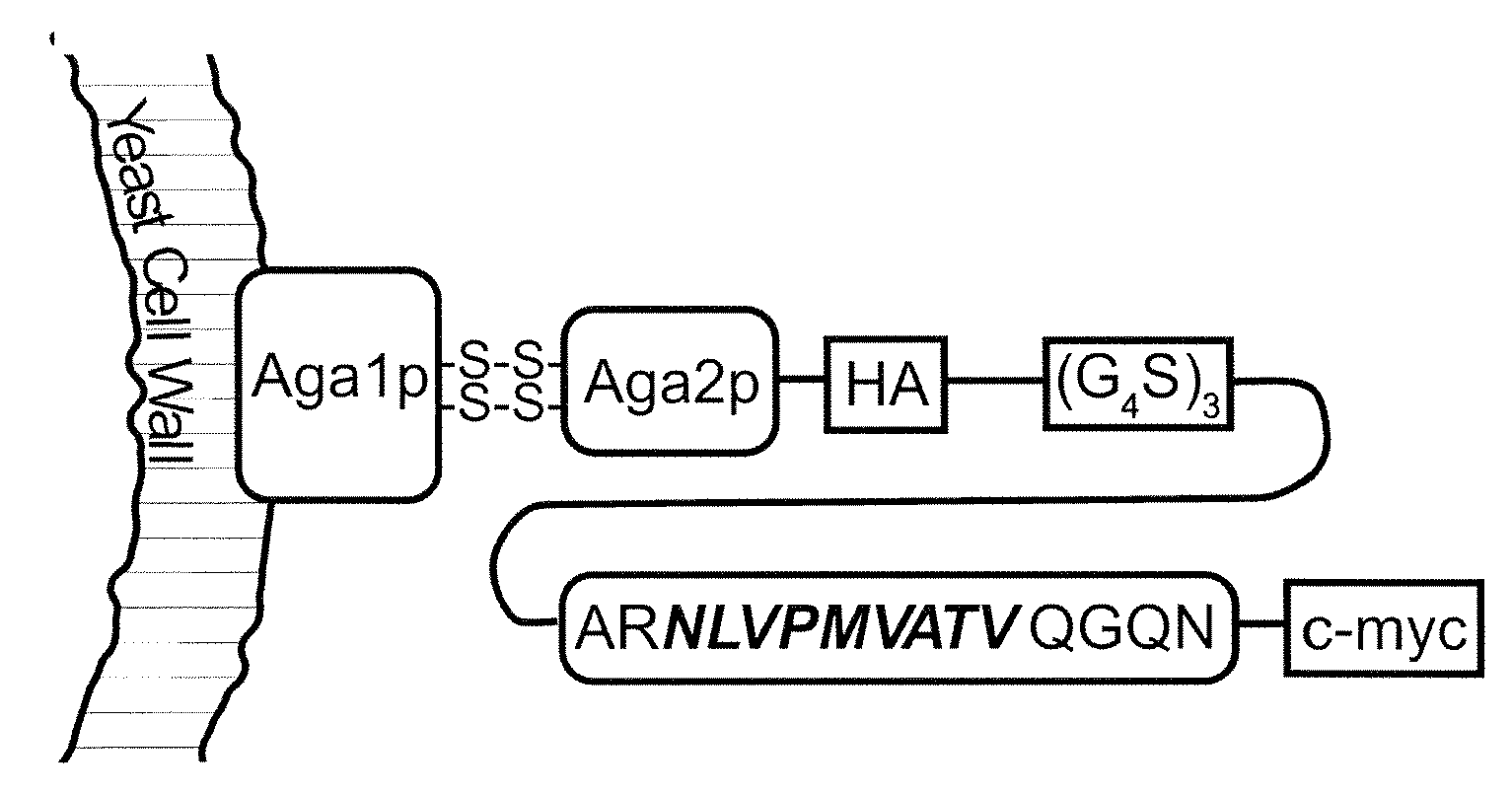Methods and compositions for increased priming of t-cells through cross-presentation of exogenous antigens
a technology of exogenous antigens and compositions, applied in the field of immunotherapy, can solve the problems of limited effectiveness of humoral immunity, cd8sup>+/sup> cytotoxic lymphocytes, and vaccines that generate effective cellular immune responses, and achieve the effect of increasing the presentation of exogenous antigens
- Summary
- Abstract
- Description
- Claims
- Application Information
AI Technical Summary
Benefits of technology
Problems solved by technology
Method used
Image
Examples
example 1
Yeast Surface-Displayed Antigen is Cross-Presented to CD8+ T Cells
[0064]We selected the well-characterized HLA-A*0201-restricted peptide NLVPMVATV (N9V) (SEQ ID NO: 4), derived from cytomegalovirus (CMV) phosphoprotein pp 65 as our model antigen, for which cognate CD8+ T cells are available commercially. To ensure proper antigen processing, we included its native flanking sequences in the yeast surface display construct, in the form of the 15-mer ARNLVPMVATVQGQN (SEQ ID NO: 5) that was consistently immunogenic in HLA-A*0201, CMV-positive individuals (Trivedi et al., 2005). The yeast surface display construct consisted of a fusion of this extended peptide to the yeast mating adhesion receptor subunit Aga2p via a (G4S)3 linker, with HA and c-myc epitope tags for detection purposes (FIG. 1A). We created the yeast strain EBYN9V with co-inducible chromosomal copies of this construct and Aga1p, with expression resulting in ˜120,000 copies / cell of the Aga2p-N9V fusion anchored to the yeast...
example 2
Surface-Displayed Antigen is Cross-Presented More Efficiently than Intracellular Antigen
[0066]We next compared cross-presentation of yeast surface-displayed antigen to antigen expressed inside the cytosol of yeast. By deleting the surface anchor sequence, the same Aga2p-N9V fusion protein was expressed intracellularly in yeast. At the same 20:1 yeast:DC ratio, cross-presentation resulting from intracellular antigen was only half that from surface-displayed antigen (FIG. 2A). This result was obtained even though the expression level of intracellular antigen was 20-30× the surface display level, as shown by the slot blot in FIG. 2B.
[0067]To try to understand the marked difference in cross-presentation efficiency between surface-displayed and intracellular antigens, we studied the effects of inhibitors of either the phagosome-to-cytosol route or the vacuolar route. Cross-presentation of surface-displayed antigen was strongly inhibited by lactacystin, a proteasome inhibitor, whereas chl...
example 3
Faster Antigen Release Within the Phagosome Results in More Efficient Cross-Presentation
[0068]The rate at which antigen is released from a phagocytosed particle influences the efficiency of cross-presentation, since antigen release is a necessary step before export into the cytosol can occur. With EBYN9V yeast, the N9V antigenic peptide could be released from the yeast cell wall by proteolysis in the phagosome or by reduction of the disulfide bonds tethering Aga2p to Agalp. The rate of the former mechanism could potentially be manipulated by including protease recognition sites N-terminal to the antigenic peptide. We targeted Cathepsin S (CatS) because unlike most other cathepsins that are active only in acidic conditions found later in phagosomal maturation, its operating range extends from pH 5.0 to 7.5 (Pillay et al., 2002). Furthermore, phagosomes in macrophages and DCs fuse preferentially with endocytic compartments enriched in CatS, with CatS activity detected in ten-minute-ol...
PUM
| Property | Measurement | Unit |
|---|---|---|
| molecular weight | aaaaa | aaaaa |
| diameter | aaaaa | aaaaa |
| diameter | aaaaa | aaaaa |
Abstract
Description
Claims
Application Information
 Login to View More
Login to View More - R&D
- Intellectual Property
- Life Sciences
- Materials
- Tech Scout
- Unparalleled Data Quality
- Higher Quality Content
- 60% Fewer Hallucinations
Browse by: Latest US Patents, China's latest patents, Technical Efficacy Thesaurus, Application Domain, Technology Topic, Popular Technical Reports.
© 2025 PatSnap. All rights reserved.Legal|Privacy policy|Modern Slavery Act Transparency Statement|Sitemap|About US| Contact US: help@patsnap.com



